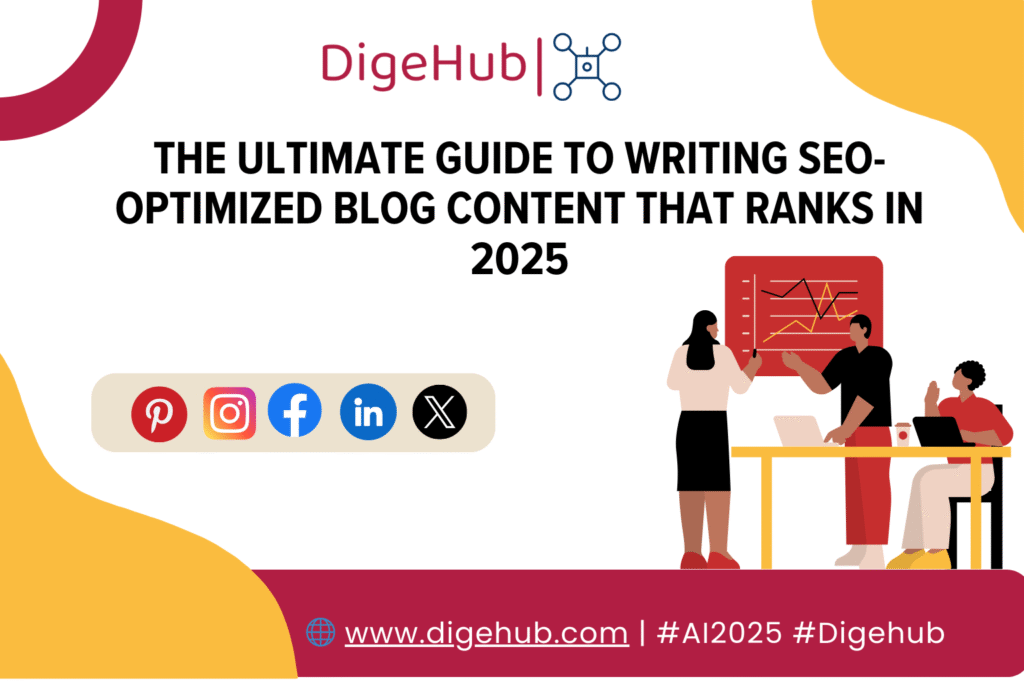
Introduction: Why SEO Blog Writing Still Matters in 2025
In the ever-evolving landscape of digital marketing, one strategy remains consistently powerful: SEO-optimized blog writing. With the right content strategy, businesses can dominate search engine results, attract highly targeted traffic, and convert readers into customers. But ranking today isn’t just about keywords—it’s about value, user intent, and optimization.
Whether you’re a digital marketer, entrepreneur, freelancer, or affiliate blogger, this comprehensive guide will teach you how to write SEO blog content that ranks in 2025. We’ll also introduce powerful tools and resources from Digehub that can take your blogging efforts to the next level.
Table of Contents
- What is SEO-Optimized Blog Writing?
- Core Elements of a High-Ranking Blog Post
- How to Choose Keywords That Actually Work
- Writing with AI: The Smart Blogger’s Secret Weapon
- Structuring Blogs for Readability & Google Snippets
- Tools & Resources for Better SEO Blogging
- Promote Your Blog & Track Performance
- Monetize Your Blog with Affiliate Offers
- Why You Need “The Ultimate AI Prompt Guide”
- Tap into Real-World Leads: India’s Biggest Business Database
- Hosting that Supports Your Growth: Hostinger Offer
- Final Thoughts & CTA
- FAQs
1. What is SEO-Optimized Blog Writing?
SEO-optimized blog writing refers to creating content that ranks high on search engines like Google, brings in organic traffic, and satisfies user intent. It involves:
- Using relevant short and long-tail keywords
- Writing clear, value-driven content
- Structuring with proper headings and formatting
- Including internal and external links
- Optimizing meta tags, images, and URL slugs
It’s not about stuffing keywords anymore—it’s about relevance and authority.
2. Core Elements of a High-Ranking Blog Post
Here are the essential ingredients of a blog post that ranks:
✔ Keyword-optimized title and meta description
✔ Engaging intro that targets search intent
✔ Scannable format with H2s and H3s
✔ High-quality, original, and informative content
✔ Internal and outbound links
✔ Mobile and Core Web Vitals-friendly page structure
Google’s algorithms reward user-first content that offers answers, resources, and real value.
3. How to Choose Keywords That Actually Work
Your keywords are the foundation of your blog. Use tools like:
- Google Keyword Planner
- Ubersuggest
- Ahrefs
- Semrush
Tips for finding strong keywords:
- Look for low-competition, high-intent phrases
- Use long-tail keywords like “best SEO blog format 2025” or “AI tools for bloggers”
- Mix primary, secondary, and LSI (Latent Semantic Indexing) keywords
Example keywords used in this blog:
- SEO-optimized blog writing
- How to rank blog posts in 2025
- AI tools for content creation
- Affiliate blogging strategies
- Best business database for leads
4. Writing with AI: The Smart Blogger’s Secret Weapon
If you’re still writing from scratch every time, you’re missing out. AI tools like ChatGPT, DeepSeek, and Jasper can help you:
- Generate optimized outlines
- Produce keyword-rich introductions
- Draft entire blog sections
- Repurpose content into social posts
💡 Use Digehub’s SEO Blog Optimizer (coming soon) to analyze and generate blog content using DeepSeek and Google Sheets.
🔗 Learn more in our blog section: Digehub Blog
5. Structuring Blogs for Readability & Google Snippets
A well-structured blog isn’t just easier to read—it’s more likely to be featured in Google Snippets.
🧩 Tips for Better Blog Structure:
- Use clear H1, H2, and H3 headings
- Add bullet points, numbered lists, and callout boxes
- Include short answers to key questions
- Keep paragraphs under 3 lines
- Use bold for highlights and key takeaways
Example Snippet-Ready Paragraph:
What is SEO in blogging?
SEO in blogging means optimizing content to rank higher in search results. It involves using keywords, structuring posts, and offering real value.
6. Tools & Resources for Better SEO Blogging
Here are some must-use tools to boost your blog’s SEO performance:
- Grammarly – Polish grammar and tone
- Surfer SEO – On-page optimization suggestions
- Yoast SEO (for WordPress) – Easy meta title, slug, and readability checks
- Digehub’s Ultimate AI Prompt Guide – AI prompt mastery for smarter blogging
🎯 Get the guide here → The Ultimate AI Prompt Guide – $6.99 only
7. Promote Your Blog & Track Performance
Your job isn’t done after hitting publish. Now it’s time to promote:
- Share on LinkedIn, X (Twitter), and Facebook Groups
- Convert blog snippets into Instagram Reels or carousels
- Use Google Search Console and Analytics to monitor traffic
- Repurpose blogs into PDFs or lead magnets
Pro Tip: Repurpose your blog with AI to create newsletters, eBooks, or video scripts.
8. Monetize Your Blog with Affiliate Offers
Here’s how smart bloggers earn from SEO blogs:
- Promote hosting plans with high commissions
- Sell eBooks or digital guides
- Offer exclusive databases or data products
- Recommend tools and software via affiliate links
🚀 Try this high-converting affiliate offer:
👉 Host your website on Hostinger and promote your blog effortlessly.
Use our referral link to sign up: Hostinger Referral
9. Why You Need “The Ultimate AI Prompt Guide”
If you’re struggling to generate engaging content consistently, this guide is for you. It helps marketers, bloggers, students, and small business owners write smarter using AI.
🎁 What You’ll Get:
- 100+ AI prompt templates
- Use-cases for blogs, social media, lead gen, and more
- Time-saving strategies for daily content workflows
Buy now for just $6.99 → Unlock The Ultimate AI Prompt Guide
10. Tap into Real-World Leads: India’s Biggest Business Database
Looking to grow your B2B business or promote products/services?
Use verified data from over millions of Indian businesses, sorted by:
- City
- Profession
- Industry type
- Contact information
👉 Explore the product: India’s Biggest Business Database
Perfect for consultants, marketers, agencies, and lead-generation campaigns.
11. Hosting That Supports Your Growth: Hostinger Offer
Your blog deserves reliable hosting. We recommend Hostinger for:
- Blazing-fast page loads
- Free domain & SSL
- Easy WordPress setup
- Affordable pricing
🎯 Ready to launch? Sign up via our referral for exclusive discounts:
👉 Hostinger Hosting via Digehub
12. Final Thoughts: Blog Smarter, Rank Higher
SEO blog writing in 2025 isn’t just a trend—it’s a necessity. Whether you’re building a personal brand or scaling your agency, this guide gives you everything you need to create, optimize, and monetize content.
✅ Use AI prompts
✅ Apply SEO best practices
✅ Promote with affiliate offers
✅ Tap into exclusive resources on Digehub
✅ Call to Action:
Ready to transform your content game?
👉 Explore our top products and start growing your digital presence:
- The Ultimate AI Prompt Guide
- India’s Biggest Business Database
- Digehub Blogs & Tools
- Hostinger Web Hosting Referral
FAQs: SEO Blog Writing in 2025
1. What is the best way to write an SEO-optimized blog post?
Start with keyword research, create a structured outline with H2s/H3s, write engaging content, and optimize for both users and search engines. Use internal and external links.
2. Do long-tail keywords help blogs rank faster?
Yes. Long-tail keywords have lower competition and higher intent, making it easier to rank and attract qualified readers.
3. Can AI tools write SEO blog posts for me?
Yes. AI tools like ChatGPT and Digehub’s upcoming Blog Optimizer can generate high-quality content using prompts and keyword inputs.
4. How often should I publish SEO blogs?
Aim for at least 2 blogs per month to stay consistent and relevant. Focus on quality, not just quantity.
5. What’s the fastest way to monetize a blog?
Use affiliate links, sell digital products like eBooks, or offer lead-based services using verified business databases.
Thanks for reading! For more expert resources, follow Digehub and supercharge your digital success today.


